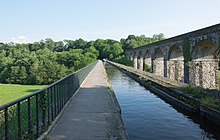Bridge in Chirk
| Chirk Aqueduct | |
|---|---|
 Chirk Aqueduct and the railway viaduct behind it Chirk Aqueduct and the railway viaduct behind it | |
| Coordinates | 52°55′42″N 3°03′44″W / 52.9282°N 3.0622°W / 52.9282; -3.0622 |
| OS grid reference | SJ287373 |
| Carries | Llangollen Canal |
| Crosses | Ceiriog Valley |
| Locale | Chirk |
| Maintained by | Canal and River Trust |
| Characteristics | |
| Trough construction | Cast iron |
| Pier construction | Masonry |
| Total length | 710 feet (220 m) |
| Height | 70 feet (21 m) |
| Traversable? | Yes |
| Towpaths | East Side |
| No. of spans | Ten |
| History | |
| Designer | Thomas Telford |
| Construction end | 1801 |
| Location | |
Chirk Aqueduct is a 70-foot (21 m) high and 710-foot (220 m) long navigable aqueduct that carries what is now the Llangollen Canal across the Ceiriog Valley near Chirk, on the England-Wales border, spanning the two countries.
History
The aqueduct was designed by civil engineer Thomas Telford for the Ellesmere Canal. The resident engineer was M. Davidson who also acted as resident engineer on a number of Telford's other works. The foundation stone was laid on 17 June 1796 and it was completed in 1801. It has a cast iron trough within which the water is contained. The masonry walls hide the cast iron interior. The aqueduct followed Telford's innovative Longdon-on-Tern Aqueduct on the Shrewsbury Canal, and was a forerunner of the Pontcysyllte Aqueduct, also on the Llangollen Canal. The aqueduct was briefly the tallest navigable one ever built, and it now is Grade II* listed in both England and Wales. It forms part of the Pontcysyllte Aqueduct World Heritage Site.
Description


The aqueduct consists of ten arches, each with a span of 40 feet (12 m). The water level is 65 feet (20 m) above the ground and 70 feet (21 m) above the River Ceiriog. The stone work is yellow sandstone. William Hazledine provided the ironwork for the aqueduct. Originally built with iron plates only at the base of the trough, iron side plates were added to the aqueduct in 1870 to alleviate leakage.
The Chirk Tunnel starts at the north end of the Chirk Aqueduct, allowing the canal to continue on towards Llangollen. Chirk Railway Viaduct was built later alongside the aqueduct. It is slightly higher than the aqueduct.
As is true for the entire Llangollen Canal, a steady current flows in the aqueduct with the narrow cross-section of the aqueduct's trough amplifying this flow.
See also
References
- ^ Glover, Julien (2017). Man of Iron - Thomas Telford and the Building of Britain. London: Bloomsbury. p. 383.
- ^ Samuel Smiles (2004). The Life of Thomas Telford. Kessinger Publishing. ISBN 1-4191-6991-2.
- Samuel Smiles (1861). Lives of the Engineers, with an Account of Their Principal Works. J. Murray.
- Historic England. "Chirk Aqueduct (Grade II*) (1295150)". National Heritage List for England. Retrieved 5 November 2015.
- ^ Chirk Conservation Area: Draft Character Assessment & Management Plan (PDF). Wrexham.gov.uk. June 2014. Retrieved 7 April 2016.
- A. W. Skempton (2002). A Biographical Dictionary of Civil Engineers in Great Britain and Ireland. Thomas Telford. ISBN 0-7277-2939-X.
- Roger Cragg (1997). Wales and West Central England: Wales and West Central England, 2nd Edition. Thomas Telford. ISBN 0-7277-2576-9.
- ^ Quenby, Ron (1992). Thomas Telford's Aqueducts on the Shropshire Union Canal. Swan Hill Press. ISBN 1-8531-0246-6.
External links
- Chirk Aqueduct at chirk.com
- 360 Degree Panoramic View at BBC Shropshire (Java Applet Required)
- Bridges in Wrexham County Borough
- Buildings and structures in Shropshire
- Navigable aqueducts in Wales
- Bridges by Thomas Telford
- Bridges completed in 1801
- Llangollen Canal
- Ellesmere Canal
- Grade II* listed buildings in Shropshire
- Grade II* listed buildings in Wrexham County Borough
- Grade II* listed bridges in Wales
- Cast iron aqueducts
- Chirk
